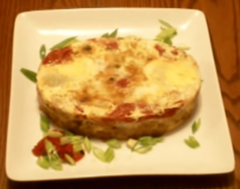Hardinera facts for kids
 |
|
| Alternative names | Jardinera, Quezon meatloaf, Lucban meatloaf |
|---|---|
| Course | Main dish |
| Place of origin | Philippines |
| Region or state | Lucban, Quezon |
| Serving temperature | hot, cold |
| Main ingredients | diced or ground pork, eggs, raisins, carrots, bell pepper, pineapple, peas, tomatoes |
| Similar dishes | embutido. morcón, menudo |
Hardinera (also called jardinera) is a yummy Filipino meatloaf. It's also known as Quezon meatloaf or Lucban meatloaf. This special dish is made with diced or ground pork. It's topped with colorful ingredients like sliced hard-boiled eggs, pineapples, carrots, bell peppers, peas, tomatoes, and raisins.
Hardinera gets its name from the Spanish word for "gardener" or "flower box." This might be because it's packed with colorful veggies, just like a garden! The ingredients are very similar to another Filipino stew called menudo. The way it's cooked is a bit like embutido, another Filipino meatloaf. Hardinera is traditionally steamed in a special oval-shaped tin mold. This mold is called a llanera, and it's also used to make the famous Filipino dessert, leche flan. This tasty dish comes from the province of Quezon on Luzon Island in the Philippines.
Contents
What is Hardinera?
Hardinera is a type of meatloaf that is very popular in the Philippines. It's not baked in an oven like many meatloaves you might know. Instead, it's cooked by steaming. This makes it very moist and tender. The main part of hardinera is usually pork. This pork is either diced into small pieces or ground up.
A Colorful Dish
What makes hardinera special is its colorful toppings and mix-ins. Imagine a delicious pork mixture filled with bright vegetables and fruits. These include sweet raisins, crunchy carrots, and juicy pineapples. You'll also find bell peppers, peas, and tomatoes. All these ingredients give hardinera a rich flavor and a beautiful look.
The Special Llanera Mold
Hardinera gets its unique oval shape from a mold called a llanera. This is a metal tin that looks a bit like a small, shallow boat. It's the same kind of mold used to make leche flan, a creamy custard dessert. Using the llanera helps the hardinera keep its shape while it steams.
Where Does Hardinera Come From?
Hardinera is a traditional dish from the Quezon Province in the Philippines. Quezon is a large province located on Luzon Island, which is the biggest island in the Philippines. Specifically, hardinera is very famous in the town of Lucban within Quezon Province. That's why it's often called "Quezon meatloaf" or "Lucban meatloaf."
A Taste of Filipino Culture
Filipino cuisine is known for its rich flavors and diverse dishes. Hardinera is a great example of how different ingredients come together to create something unique. It shows the creativity of Filipino cooking. Many Filipino dishes are passed down through families, and hardinera is one of those beloved recipes.
How is Hardinera Made?
Making hardinera involves a few steps, but the main cooking method is steaming. First, the pork is prepared with all the other ingredients. This mixture is then carefully placed into the llanera molds.
The Steaming Process
Once the mixture is in the molds, they are placed into a steamer. Steaming cooks the hardinera gently and evenly. This method helps the meatloaf stay moist and flavorful. It also allows the different ingredients to blend their tastes together perfectly. After steaming, the hardinera is cooled, and then it's ready to be served.
Similarities to Other Dishes
Hardinera shares some similarities with other Filipino dishes:
- Like Menudo: The ingredients used in hardinera are very similar to those found in menudo. Menudo is a popular Filipino stew made with pork, liver, and diced vegetables like carrots, potatoes, and bell peppers.
- Like Embutido: The cooking process of hardinera is similar to embutido. Embutido is another Filipino meatloaf, but it's usually rolled up like a sausage before it's steamed. Both dishes are often served at parties and special gatherings.
When Do People Eat Hardinera?
Hardinera is a versatile dish that can be enjoyed in many ways. It's considered a main dish, meaning it's the star of the meal.
For Special Occasions
Because of its rich taste and appealing look, hardinera is often prepared for special events. You might find it at fiestas, birthdays, or holiday celebrations. It's a dish that brings people together and adds a festive touch to any gathering.
Served Hot or Cold
One great thing about hardinera is that it can be served either hot or cold. This makes it a convenient dish for parties, as it can be prepared ahead of time. Whether it's freshly steamed and warm, or chilled and sliced, it's always delicious. It's perfect with a side of rice, which is a staple in Filipino meals.

